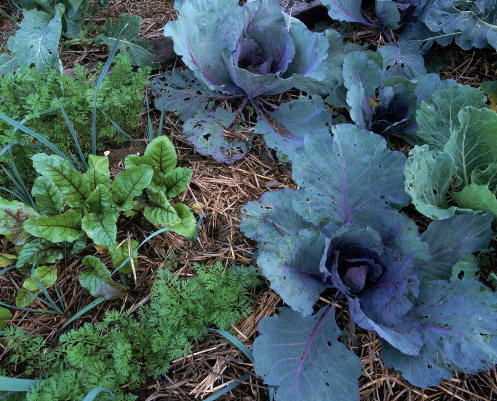Julie M. Falk
Adams County Master Gardener
 Vegetable gardening has gained in popularity this year, with many folks who normally grow a few houseplants turning over a plot in the backyard for some plants they hope to eat. Adams Countyís Master Gardeners have found people
very receptive to their educational programs as these "Recession Gardens" have been planned and planted. In response to peopleís need, weíre trying to pass on more information in our newspaper columns about cultivating the ordinary vegetables we have in our kitchen gardens.
Vegetable gardening has gained in popularity this year, with many folks who normally grow a few houseplants turning over a plot in the backyard for some plants they hope to eat. Adams Countyís Master Gardeners have found people
very receptive to their educational programs as these "Recession Gardens" have been planned and planted. In response to peopleís need, weíre trying to pass on more information in our newspaper columns about cultivating the ordinary vegetables we have in our kitchen gardens.
If youíve planted vegetable seeds or plants this season, youíll be thinking next about how to keep them alive and thriving. One of the issues youíll deal with will be whether to mulch your vegetable garden. The benefits of mulching are well established in agricultural science and in gardening lore.
Thereís really not much argument about whether you should mulch (yes, you should), but plenty of discussion about when and with what.
Mulch is a material that you spread beneath and between your plants for one or more of the following reasons: it helps to retain moisture in the soil; it suppresses the growth of weeds; it insulates the soil and prevents compaction. Some mulches also add nutrients to the soil.

Organic mulching materials include straw, grass clippings, chopped leaves, old hay, compost, and shredded bark. The most popular inorganic choices for vegetables are polyethylene plastics. Of course, the organic choices are the ones that add nutrients, which vegetables need as much as we do. Mulch
is generally spread 2 to 4 inches deep and should not be extended right up to the plant stems. Leave a couple of inches around the stem free of mulch to allow circulation.
Before mulching, let the garden soil be warmed by the spring sun to give seedlings a supportive environment. Many seeds will not germinate if the soil is too cold. After the garden is planted, most gardeners first put down mulch between the rows in order to keep down the population of weeds. This
also provides a nice pathway for working and walking in your garden. If youíve planted seeds, you will likely wait until they have sprouted and grown a few inches to place mulch around the plants. If youíve transplanted larger plants from pots, they may be ready for mulching right away. Here are some tips specific to a few
of the most commonly planted vegetables. I credit much of this advice to Stu Campbell from his book Mulch It!
Beans are generally ready for mulching 2 to 3 weeks after planting. Mr. Campbell recommends a fine mulch to inhibit weed growth. Thatís particularly important for beans because their roots grow close to the surface and can be disrupted by clawing and hoeing the weeds.
Beets like alkaline soil, so itís best to avoid acidic mulches like pine needles, oak leaves or straight peat.
Broccoli and cauliflower like non-acidic organic mulches as well. You can also lay down plastic mulch and cut holes in it for transplanting young plants. Itís possible to extend the season for these naturally frost-resistant plants by applying insulating mulch late in the season.
Cantaloupes and melons prefer thick organic mulch, such as hay, grass clippings, buckwheat hulls or even newspaper. When the plants send out runners, make sure they are able to absorb moisture from the soil, but rest the melons themselves on thicker mulch so they wonít rot.
When corn is about, you know, knee high Ė itís time to mulch.
Cucumbers are ready for mulching when they grow to about three inches. Mr. Campbell recommends chopped leaves, straw or old hay, keeping the mulch 3 to 4 inches away from the main plant.
Squash can take a deeper mulch, as much as 4 inches, especially to hold in soil moisture during hot, dry spells. Again, donít mulch up to the stem of the main plant so that the sunís heat can reach the plant.
It is important to note that tomatoes are one of the plants you can mulch too early. Tomatoes, peppers and corn require well-warmed soil to encourage their growth early in the season. If you mulch too early, their growth will be slowed. Tomato plants do well with plastic mulches, and research has
shown that red plastic has the most beneficial effect on growth. Plastic can be used at the time of planting or shortly after. If youíre using an organic mulch on your tomatoes, wait until just after the flowers appear.
With proper mulching, your garden will be more productive and your weeding chores light.
Read other articles on growing herbs or vegetables
Read other articles by Julie Falk